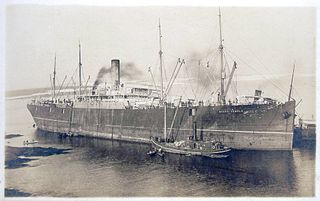
RMS Celtic was an ocean liner owned by the White Star Line. The first ship larger than SS Great Eastern by gross register tonnage, Celtic was the first of a quartet of ships over 20,000 tons, the dubbed The Big Four. She was the last ship ordered by Thomas Henry Ismay before his death in 1899. The second liner of her name she was put into service in 1901. Her large size and her low but economical speed inaugurated a new company policy aiming to favour size, luxury and comfort, to the detriment of speed.

Mount Temple was a passenger cargo steamship built in 1901 by Armstrong Whitworth & Company of Newcastle for Elder, Dempster & Co Ltd of Liverpool to operate as part of its Beaver Line. The ship was shortly afterwards acquired by the Canadian Pacific Railway. It was one of the first vessels to respond to the distress signals of RMS Titanic in 1912.

SS Abyssinia was a British mail liner built in 1870, and originally operated by the Cunard Line on the Liverpool–New York route. She later served the Guion Line on the same route and the Canadian Pacific Line in the Pacific. In December 1891, Abyssinia was destroyed mid-Atlantic without loss of life by a fire that started in her cargo of cotton, further highlighting the danger in carrying both cotton and passengers on the same ship.

SS Polar Chief was a merchant steamship that was built in England in 1897 and scrapped in Scotland in 1952. In its 55-year career it had previously been called Montcalm, RFA Crenella, Crenella, Rey Alfonso, Anglo-Norse and Empire Chief. Early in the First World War it spent eight months pretending to be the battleship HMS Audacious.
TSS Colleen Bawn was a twin screw passenger steamship operated by the Lancashire and Yorkshire Railway from 1903 to 1922.
TSS Mellifont was a twin screw passenger steamship operated by the Lancashire and Yorkshire Railway from 1903 to 1928.
PS Isabella was a paddle steamer passenger vessel operated by the London and North Western Railway from 1877 to 1898.
PS Lily was a passenger paddle steamer operated by the London and North Western Railway from 1880 to 1900.

SS Violet was a passenger paddle steamer operated by the London and North Western Railway from 1880 to 1902.
TSS Slieve Gallion was a twin screw steamer cargo vessel operated by the London and North Western Railway from 1908 to 1923, and the London, Midland and Scottish Railway from 1923 to 1937.

TSS Rathmore was a twin screw steamer passenger vessel operated by the London and North Western Railway from 1908 to 1923, and the London, Midland and Scottish Railway from 1923 to 1927.
TSS Slievemore was a twin screw steamer passenger and cargo vessel operated by the London and North Western Railway from 1904 to 1923, and the London, Midland and Scottish Railway from 1923 to 1932.
TSS Slieve Bawn was a twin screw steamer passenger and cargo vessel operated by the London and North Western Railway from 1905 to 1923, and the London, Midland and Scottish Railway from 1923 to 1935.
TSS Slieve Bloom may refer to:
TSS Slievemore or Slieve More may refer to:
TSS Rosstrevor was a steam turbine passenger and cargo vessel operated by the London and North Western Railway from 1895 to 1923, and the London, Midland and Scottish Railway from 1923 to 1926.
TSS Slieve Donard was a steam turbine passenger and cargo vessel operated by the London and North Western Railway from 1921 to 1923, and the London, Midland and Scottish Railway from 1923 to 1948.
PS Glen Rosa was a 306 GRT passenger paddle steamer that J&G Thomson launched in 1893 for the Glasgow and South Western Railway (G&SWR). She served with the Royal Navy in the First World War as HMS Glencross. She was absorbed into the London, Midland and Scottish Railway fleet in 1923, transferred to the Caledonian Steam Packet Company in 1938 and scrapped in 1939.
PS Slieve Donard was a United Kingdom passenger paddle steamer that in different periods of her history was also called PS Albion and HMS Albyn. Albion is the name she bore the longest and may be the one by which she is better known in England. Slieve Donard was her original name and the one by which she will be best known on the island of Ireland.
SS Derwent was a passenger and cargo ship built for the Goole Steam Shipping Company in 1888.





